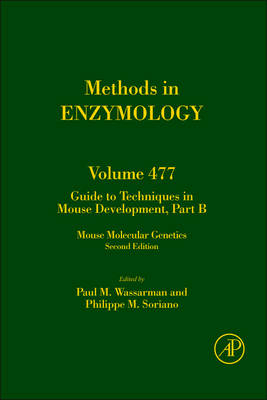
Guide to Techniques in Mouse Development, Part B
Academic Press Inc (Verlag)
978-0-12-384880-2 (ISBN)
Philippe Soriano,is Professor of Cell, Developmental & Regenerative Biology and Professor of Oncological Sciences, Icahn School of Medicine at Mount Sinai, NY, USA
Section I. Transgenesis 1. Lentivirus transgenesis Alexander Pfeifer and Katrin Zimmermann 2. Germline modification using mouse spermatogonial stem cells Mito Kanatsu-Shinohara and Takashi Shinohara 3. Embryonic in vivo electroporation in the mouse Tetsuichiro Saito Section II. Transposons 4. Current applications of transposons in mouse genetics Adam J. Dupuy 5. Functional genomics in the mouse using the Sleeping Beauty transposon system Kyoji Horie, Chikara Kokubu, and Junji Takeda 6. The use of DNA transposons for cancer gene discovery in mice George Vassiliou, Roland Rad, and Allan Bradley Section III. Recombinases 7. A practical summary of site specific recombination, conditional mutagenesis, and tamoxifen induction of CreERT2 Konstantinos Anastassiadis, Stefan Glaser, Andrea Kranz, Kaj Berhardt, and A. Francis Stewart 8. A recombineering pipeline to make conditional targeting constructs Jun Fu, Madeleine Teucher, Konstantinos Anastassiadis, William Skarnes, and A. Francis Stewart 9. Confirmation of recombination site functionality in gene targeting vectors using recombinase-expressing bacteria M. David Stewart and Richard R. Behringer 10.Genetic fate mapping using site-specific recombinases Emilie Legué and Alexandra L. Joyner 11. Mapping cell fate and function using recombinase-based intersectional strategies Susan M. Dymecki, Russell S. Ray, and Jun C. Kim Section IV. Mutagenesis 12. Genome-wide forward genetic screens in mouse ES cells Meng Amy Li, Stephen J. Pettitt, Kosuke Yusa, and Allan Bradley 13. Gene trap mutagenesis in the mouse Roland H. Friedel and Philippe Soriano 14. A wider context for gene trap mutagenesis Joshua M. Brickman, Anestis Tsakiridis, Christine To, and William L. Stanford 15. Mouse mutagenesis with the chemical supermutagen ENU Frank J. Probst and Monica J. Justice 16. Phenotype-driven mouse ENU mutagenesis screens Tamara Caspary 17. Using ENU mutagenesis for phenotype-driven analysis of the mouse. Rolf W. Stottmann and David R. Beier Section V. Gene Knockdowns 18. Exploration of self-renewal and pluripotency in ES cells using RNAi Christoph Schaniel, Dung-Fang Lee, and Ihor R. Lemischka 19. Transgenic RNAi applications in the mouse Jost Seibler and Frieder Schwenk 20. Gene knockdown in the mouse through RNAi Aljoscha Kleinhammer, Wolfgang Wurst, and Ralf Kühn 21. In vivo analysis of gene knock-down in tetracycline-inducible shRNA mice Christopher S. Raymond, Lei Zhu, and Myung K. Shin 22. The power of reversibility: Regulating gene activities via tetracycline controlled transcription Kai Schönig, Hermann Bujard, and Manfred Gossen Section VI. Gene Expression Profiling 23. Gene expression profiling of mouse oocytes and preimplantation embryos Francesca E. Duncan and Richard M. Schultz 24. Interrogating the transcriptome of oocytes and preimplantation embryos Anne E. Peaston, Joel Graber, Barbara B. Knowles, and Wilhelmine N. de Vries 25. Gene expression profiling of mouse embryos with microarrays Alexei A. Sharov, Yulan Piao, and Minoru S. H. Ko
| Erscheint lt. Verlag | 24.9.2010 |
|---|---|
| Reihe/Serie | Methods in Enzymology |
| Verlagsort | San Diego |
| Sprache | englisch |
| Maße | 152 x 229 mm |
| Gewicht | 1110 g |
| Themenwelt | Medizin / Pharmazie |
| ISBN-10 | 0-12-384880-6 / 0123848806 |
| ISBN-13 | 978-0-12-384880-2 / 9780123848802 |
| Zustand | Neuware |
| Haben Sie eine Frage zum Produkt? |
aus dem Bereich


